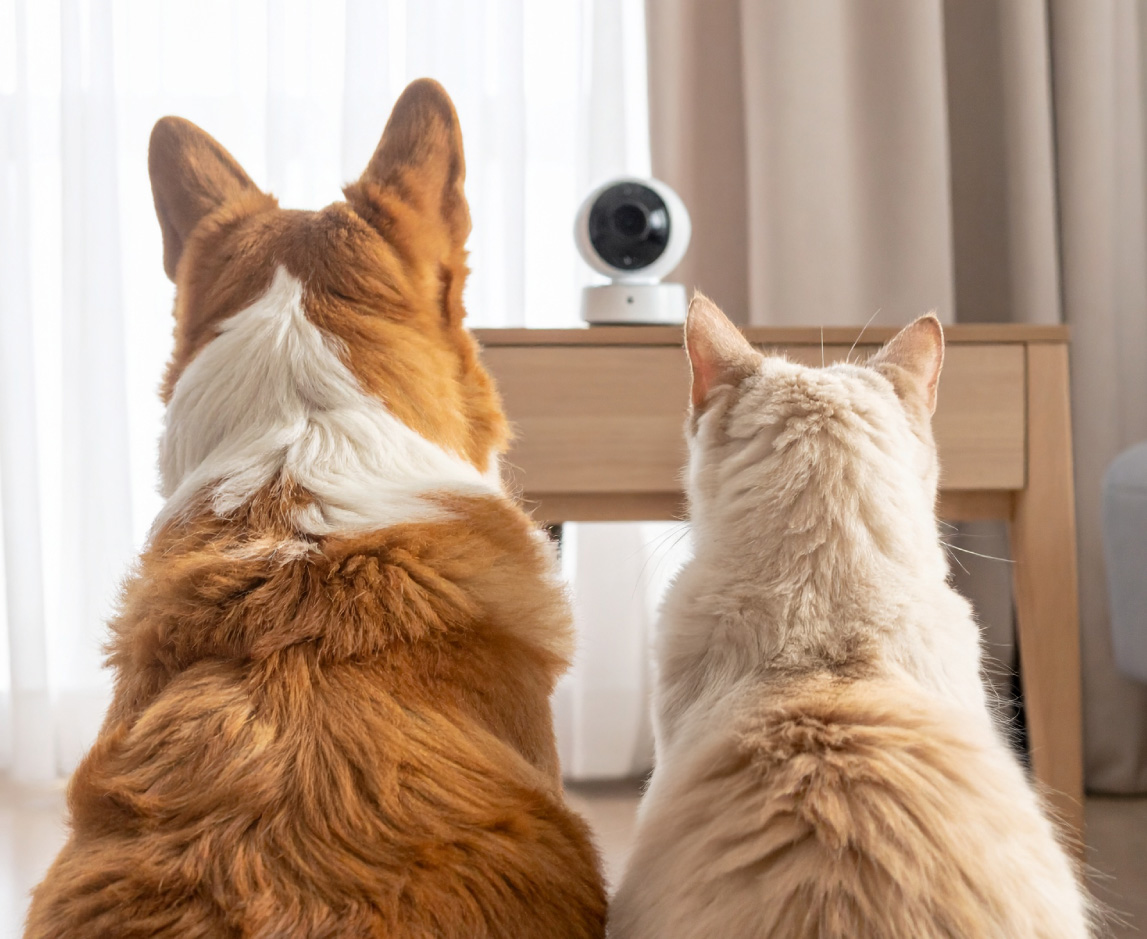As any cat owner can attest, cats love toys. Whether it’s a jingle ball they like to bat around the house or a crinkly stuffed animal they like to kick, toys are a great outlet for domestic cats to get out their energy and exercise their natural hunting skills.
Luckily, cats don’t need expensive or high-tech toys to keep them occupied; often, they are just as happy to play with a new toy as the box it came in. This is great news for cat owners, as there are many fun homemade cat toy tutorials out there that won’t cost a penny and utilize materials you likely already have at home.
How Often Should You Play With Your Cat?
Though they can amuse themselves, cats like to play with each other, other pets in the house and their humans — especially if that human is wielding a feather wand or string toy. One to two fifteen-minute play sessions a day should be enough to satisfy your cat, though you may find their capacity for play changes depending on their age or energy level. Young cats and kittens can chase balls seemingly for hours, which most are happy to do without human participation.
Contrary to their standoffish reputation, cats are social mammals that crave connection (albeit on their terms), so playtime is a valuable opportunity to give your cat attention, mental stimulation and some physical exercise. End each play session with a treat or by allowing your cat to catch and keep their toy. This reward system will help them develop a positive association to playtime, especially if they need help with socialization.
Don’t force your cat to play if they don’t feel like it, such as while they’re sleeping, eating or simply not in the mood (watch their body language). An unplayful cat may feel like you’re antagonizing them, and cats aren’t shy with their claws or teeth when they get annoyed.
When you can’t make time to play with your cat, leave toys around the house to prevent them from getting bored while you’re busy (provided they are cat-safe — see below). Bored cats can become destructive, so make sure they have easy access to toys that can distract them from clawing your drapes.
Easy DIY Cat Toys & How To Make Them
Now for the fun part! Most of these toys can be made out of simple household materials, and many are great projects to do with kids. Feel free to put your own cat-safe spin on any of the crafts below. Crafts are listed in order of simplicity.
Pom Pom Rattle Tube
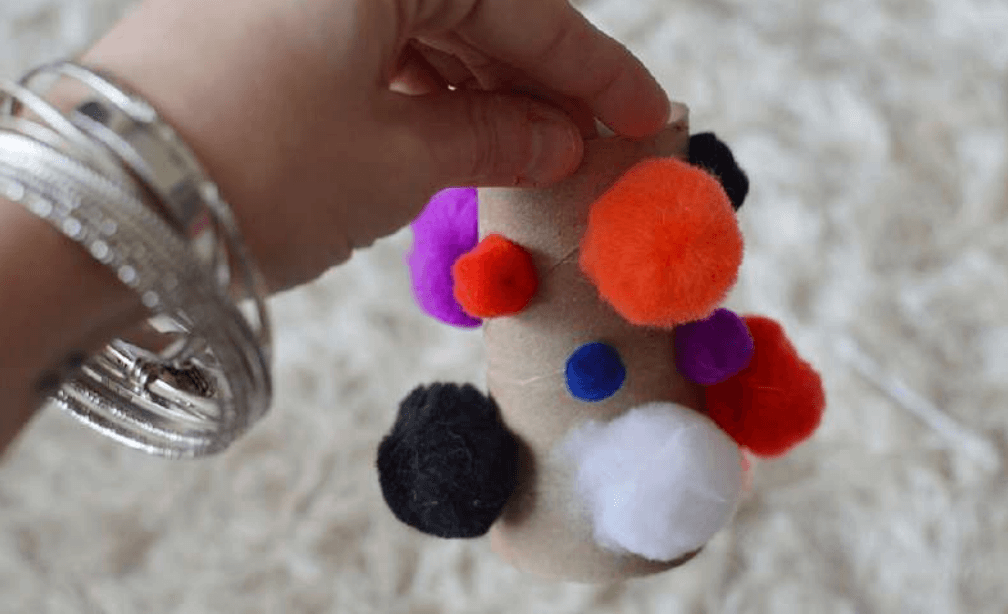
Materials:
Toilet paper tube
Pom poms (optional)
Hot glue
Cat treats
Instructions:
1. Optional: With a hot glue gun, glue pom poms evenly around the toilet paper tube. These will give the cat something to grab onto while playing.
2. At one end of the tube, fold the edges in until one slightly overlaps the other. Drop several treats inside the tube and fold the other end in.
3. That’s it! Roll it toward your cat and watch them try to pry open the ends of the tube to get at the treats.
T-shirt Knots
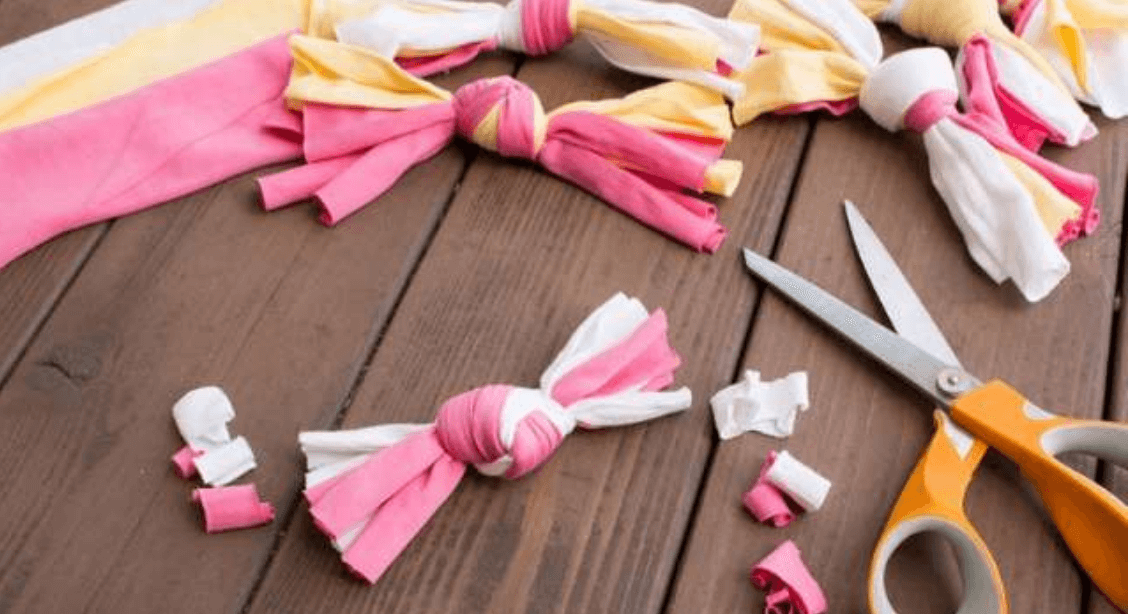
Materials:
Old t-shirt
Ruler
Pencil or Sharpie
Scissors
Instructions:
1. Lay a t-shirt on a flat surface. Starting at the bottom edge, draw 6 skinny rectangles 1” wide by 10” tall.
2. Cut the rectangles out until you have 6 long strips of fabric.
3. Stack all 6 strips together and tie together with a single knot at the center.
4. Toss to your cat and let playtime commence. Make as many of these as your house can handle!
Puzzle Tub
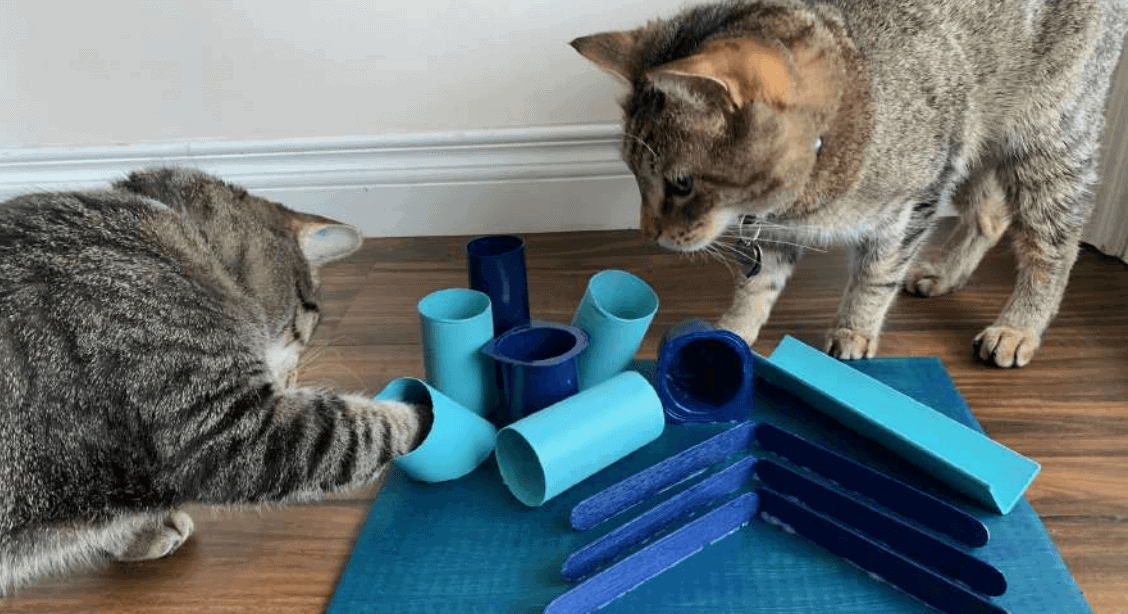
Materials:
Old Tupperware container with lid
Sharpie or marker
Scissors or box cutter
Sandpaper
Leather awl (optional)
Jingle bell (optional)
String (optional)
Small ball (rubber, jingle, ping pong, etc.) or mouse toy
Cat treats
Instructions:
1. Lay the container lid on a flat surface. You’ll be cutting two separate holes in the lid, each large enough for your cat’s paw to fit through.
2. Use the ball of your choice to trace two circles on the container lid, making sure the circles are large enough for your cat’s paw. Cut the circles out with the scissors or box cutter against a flat surface safe for cutting.
3. Sand the edges of each circle with the sandpaper until they are no longer sharp.
a. Optional: Use the awl to poke two more holes in the center of the lid, side by side, large enough for your string to pass through. If you don’t have an awl, any sharp pointed tool will work.
b. Thread the jingle bell onto the string. From the underside of the container lid, thread each end of the string up through an awl hole and tie the ends together tightly on top of the lid.
4. Place the ball/mouse toy and a handful of treats into the container and close the lid tightly.
5. Let your cat try to figure out how to get the treats and/or toy out of the container while enjoying the (optional) jingling sound of the bell.
Treasure Box
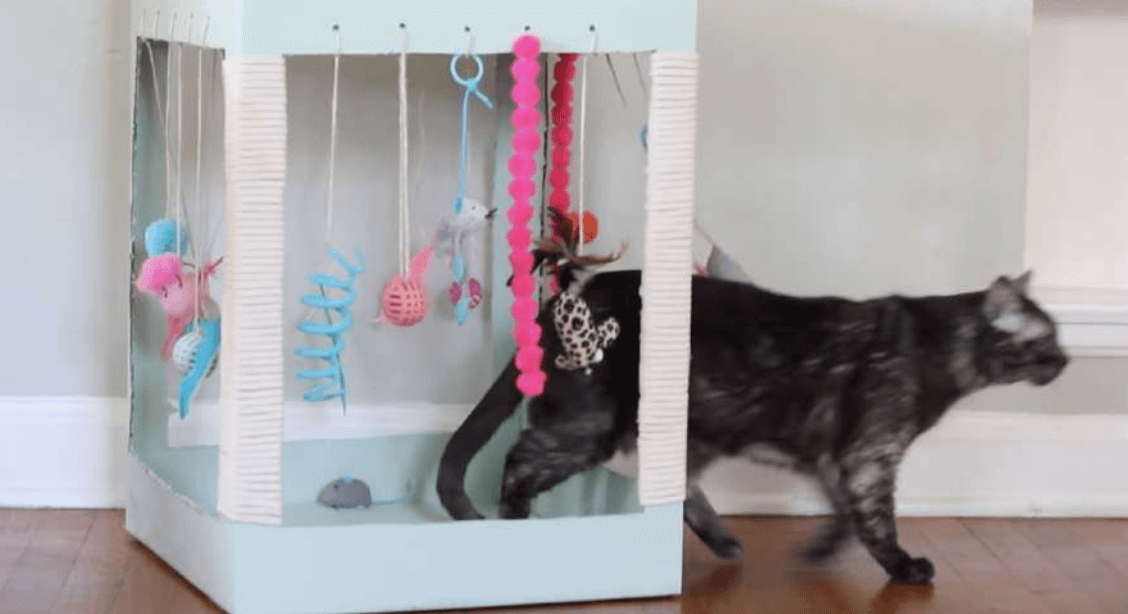
Materials:
Shoebox or similar sized, shallow cardboard box
Toilet paper tubes and/or paper towel tubes
Egg carton (paper or plastic)
Scissors
Hot glue gun
Cat treats, catnip and/or small cat toys
Instructions:
1. If your box comes with a lid or flaps, discard or detach. Do the same with the egg carton and cut the remaining portion into thirds using scissors. (If the carton is plastic, sand the cut edges until smooth.)
2. Trim the cardboard tubes until they are each as long as the box is deep.
3. Stand the tubes up in the box along with the egg carton segments and arrange however you like. Once you are satisfied with the placement, hot glue each piece to the floor of the box, making sure the edges of the tubes are sufficiently fastened on the bottom.
4. Place cat toys and/or treats into the box, spreading them evenly between the tubes and carton sections.
5. Place the box on the floor and let your cat try to figure out how to retrieve their treats or toys from the various compartments.
Catnip Kicker
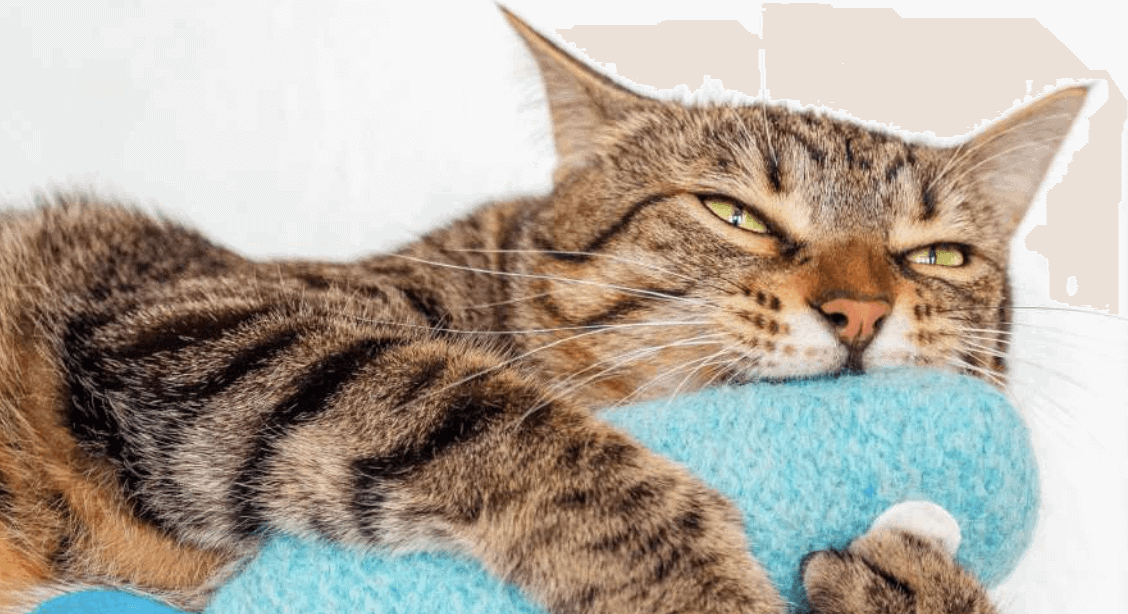
Materials:
Old sweater, long sock or long-sleeved shirt
Scissors
Fiber fill
Dried catnip
Newspaper
String or yarn
Hot glue (optional)
Instructions:
1. If using an old sweater or long sleeved shirt, detach one of the sleeves with scissors and trim into a segment roughly 1’ long. If using a sock, cut the foot portion off to leave a tube that’s open at both ends.
2. Portion out enough fiber fill to stuff your fabric tube. Sprinkle dried catnip generously throughout the fiber fill.
3. Lay a sheet of newspaper on a flat surface and place the fiber fill along one edge. Roll the fiber fill up in the newspaper and fold in the ends until the bundle is slightly shorter than your fabric tube.
4. Insert the wrapped bundle into your fabric tube.
5. Twist both ends of the tube closed and tie tightly with string. (Hint: Some hot glue under the string and on the knot will ensure the tube stays closed.)
6. Enjoy watching your cat kick and wrestle with their new crinkly catnip toy!
Tassel Wand
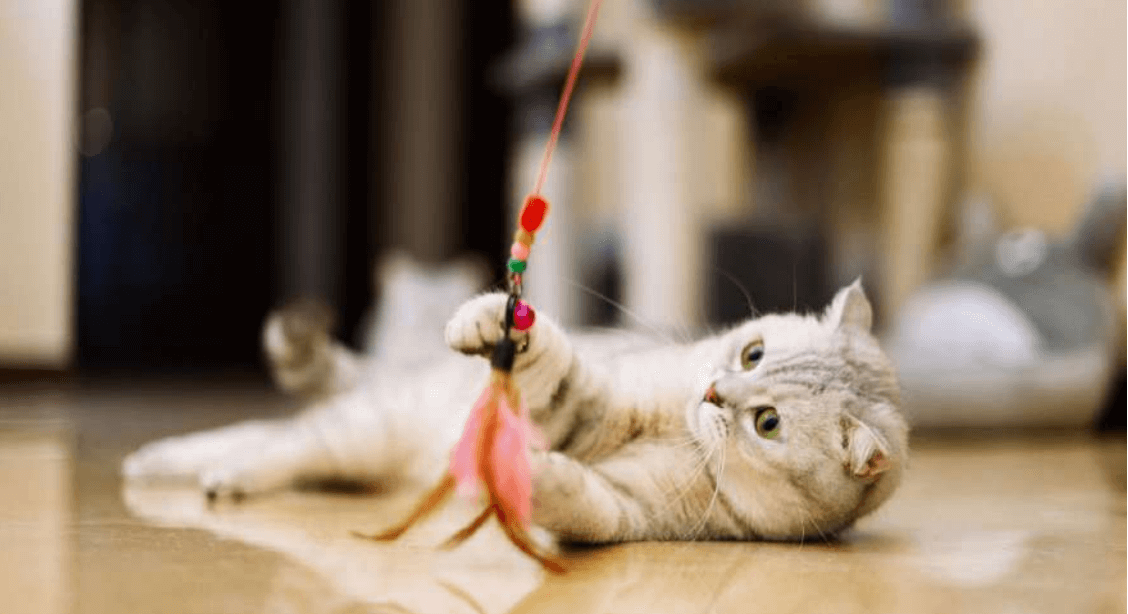
Materials:
Thin wooden dowel, ~1.5’ long
Cotton twine
Scissors
Hot glue
Faux leather, canvas or other tough fabric
Glasses case or similar sized object
Leather cord (variations: feathers, ribbons, wine cork…)
Instructions:
1. Measure and cut a length of cotton twine about 2.5’ long, making sure you have some left over.
2. Lay one end of the twine along one end of the dowel so the ends overlap by about 3”. Glue the end of the string to the dowel.
3. Cut out a 4” x 4” rectangle of faux leather or other tough fabric. Roll the fabric around the end of the dowel with the string attached, keeping the rest of the string clear and the tip of the dowel flush with the edge of the fabric. Glue the fabric in place.
4. If using leather cord to make a tassel, wrap the cord around a glasses case or similar sized object about 10–15 times and cut (more cord means a fluffier tassel).
5. Thread the loose end of the cotton twine through the looped leather cord and it tightly to itself. Secure the knot with a dot of glue.
6. Slide the looped cord off the glasses case and cut through the middle of the loop opposite the cotton twine knot.
7. Fold the cut cords in half with the cotton twine knot in the center, creating a tassel. Using a separate piece of cotton twine, wind the twine around the top of the tassel, tie and glue tightly in place.
a. If using ribbon, follow the same steps above to create a tassel.
b. If using feathers, a wine cork, etc., simply tie and glue your chosen object to the end of the twine.
8. Time to go fishing for a cat! Watch them jump and reach for that pesky tassel.
T-shirt Cat Tent
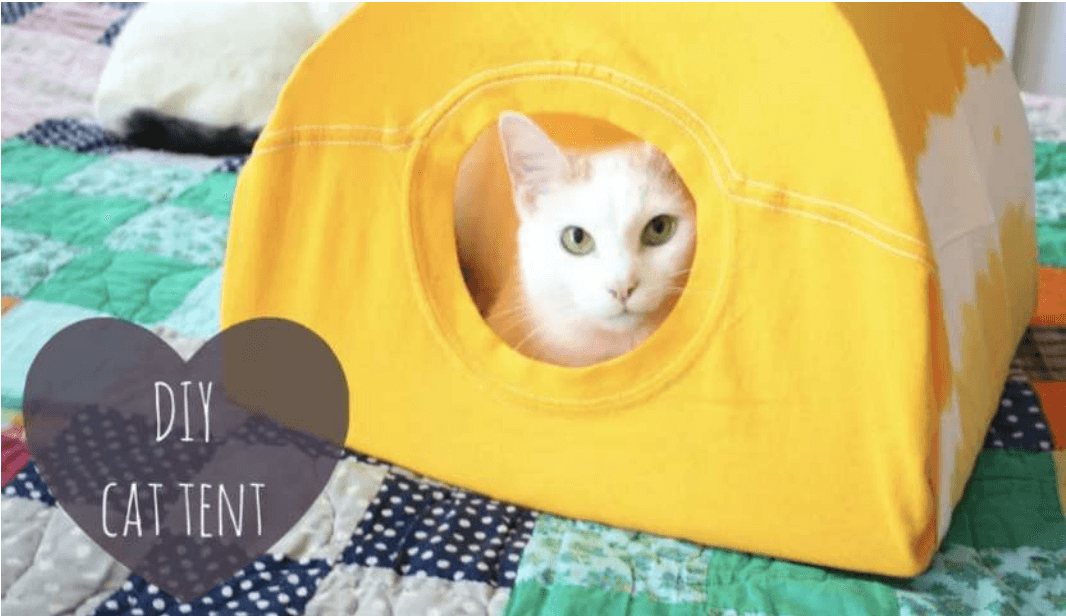
Materials:
Medium t-shirt
15” x 15” piece of flat cardboard
Two wire clothes hangers
Pliers or wire cutters
Duct tape
Safety pins
Cat blanket
Instructions:
1. Using the pliers or wire cutters, cut the top off each hanger so that you have two lengths of plain wire. Bend them into two identical U-shaped curves.
2. Cover each edge of the cardboard in duct tape to create smooth edges.
3. Using the end of one of the wire pieces, poke a hole in each corner of the cardboard, at least ½” from the edge.
4. Arrange the wire curves so that each end is inserted into a hole diagonally opposite, making a “cage.” Tape the two wire curves together where they meet in the center at a perpendicular angle.
5. Using the pliers, bend each wire end under the cardboard to hold the “cage” in place. Make sure the ends of the wires are flush against the bottom of the cardboard and tape in place.
6. Insert the entire structure into the t-shirt from the bottom and arrange so that the neck hole is in the center of one of the four sides. Gather the sleeves and remaining fabric of the shirt underneath the cardboard and fasten in place with safety pins. Make sure the fabric is stretched taut over the sides of the structure and lies flat against the bottom of the cardboard.
7. Place your cat’s blanket inside the finished tent and invite them to explore their new playhouse.
Cardboard Cat Palace

Materials:
One large cardboard box or two mid-sized boxes
Sharpie
Box cutter
Hot glue
Instructions:
Note: This project is intentionally open-ended. Use your imagination to create a unique structure!
1. Fold the bottom of your box (or one of your boxes) closed and glue the flaps in place.
2. Lay your box (or one of your boxes) on its side on a flat surface that’s safe for cutting on. Draw windows and a door large enough for your cat to fit through on the inside of the box in whatever arrangement you’d like. Use a box cutter to cut out the shapes.
3. If using one large box, simply toss your cat’s favorite blanket, toys, some treats or catnip into the box, fold the top flaps closed and glue in place. Once the glue is dry, your cat palace is complete!
a. If you have a second box, you can now make a two-story palace.
b. Draw and cut out windows in the second box.
c. Fold and glue the bottom flaps shut.
d. Stack the second box on top of the first and glue in place. Through the open top of the second box, cut a hole between the two “floors” of the palace with a box cutter.
e. Once all the glue is dry, your two-story cat palace is complete! Finish off with cat blankets, toys, treats and your cat.
What Types of Toys Do Cats Like?
Prey-style toys:
Even if they’re strictly indoor pets, all cats retain their natural hunting instincts. They love toys that look and move like their natural prey, such as toys modeled after mice, fish or birds. In play sessions with your cat, try to mimic the way these animals move: Send feather toys “flying” across the room, make mice toys appear to scurry and so on.
Puzzle toys:
Even though they sleep a lot, cats can get very engaged and energized by problem-solving. If there’s a tangible reward involved, such as a treat or favorite toy, a cat will spend hours attempting to retrieve an object out of a hard-to-reach place.
Hiding places:
Cats feel safe in small spaces as long as they have an escape route. They also prefer to avoid conflict and may get scared easily, so a box or cat tent provides a perfect refuge. Hiding places surrounded by cardboard or fabric are also insulating, and cats love to be warm.
What Types of Toys Do Cats Dislike?
Though they can get creative with their playtime, cats may not tolerate certain types of toys.
Tinfoil: Cats generally can’t stand the sound tinfoil makes when they step on it, the texture under their paws or the feel of it on their teeth. Tinfoil can also have edges sharp enough to pierce skin.
Sticky surfaces: It may make for a funny video, but cats hate it when things like tape or glue get stuck to their paws or fur.
Loud toys: Dogs may like squeaky toys, but cats in general are not fans of loud noises. Steer clear of mechanical or battery-powered toys that may startle and alarm your cat.
What Toys Are Safe For Cats?
Most of these toys are safe for cats to play with by themselves, but if possible, keep an eye on your cat’s play sessions while you're home to make sure they don’t injure themselves or swallow anything they shouldn’t.
Plush toys: Stuffed fabric toys are great for cats, as long as they are made of sturdy enough fabric to resist ripping.
Catnip/catnip-filled toys: Catnip is a harmless plant with leaves that have an entrancing effect on almost all cats. A catnip-filled toy is a great diversion, although some cats like to eat or roll around in the leaves, fresh or dried. If your cat likes to eat catnip, don’t give them more than a tablespoon at a time to prevent vomiting.
Balls: Ping pong, foam, bouncy, jingle — smaller balls make great cat toys, as long as they are large enough that your cat can’t swallow them.
Plastic shower rings: Cats will happily chase and chew on tossed plastic shower rings — the sturdier the better.
Paper bags and cardboard boxes: Cats love to hide in and pounce on crinkly paper bags and boxes. Be sure to remove any handles on paper bags to prevent your cat getting caught in them.
Laser pointers: Cats will chase a little red dot for hours while you stay comfortably in one spot. They may become perplexed by their inability to catch and keep it, but they will not be deterred. Just be careful not to shine the light in your cat’s eyes.
Feathers: Toys with feathers are fine under human supervision, but make sure your cat doesn’t swallow any loose feathers. Indigestible feathers can cause intestinal blockages.
Even if all your cat’s toys are cat-safe, watch to see if they start licking or sucking on certain materials excessively. This could be a sign of a medical issue or nutritional deficiency, and you should inform their vet.
How to Clean Cat Toys
Cat toys take a beating during play sessions, and some well-loved toys can become pretty dirty. Most cat toys can be cleaned fairly easily.
Plush toys: Place toys in a mesh bag and wash in the washing machine with scent-free detergent. Tumble dry on low.
Rubber or plastic toys: Soak in hot, soapy water for 20 minutes, rinse and air dry.
Hiding places (like a cat tent or palace): Spot clean with a damp cloth or detach fabric portions and wash in the washing machine.
Cat beds and blankets: Vacuum or lint roll regularly. Wash in the washing machine about once a month and tumble dry on low.
Catnip-filled toys: For toys with sewn-in catnip, spot clean with a damp cloth. For refillable toys, empty them and wash according to their material, then refill with new catnip
Fether toys: Spot clean with a damp cloth (feathers won’t survive the washing machine).
What Toys Are Unsafe For Cats?
It can be hard to convince them otherwise, but there are some household items that cats should not get their claws on during playtime.
Loose pieces of string or yarn: Cats can swallow pieces of string that are not attached to anything, leading to intestinal discomfort and possibly surgery.
Toys with small pieces or fillings: Avoid toys with small, detachable pieces or fillings, as they present a choking hazard.
Rubber bands: Tempting to chew on, but not digestible and potentially harmful if swallowed.
Plastic bags or bubble wrap: Cats can get tangled in thin sheets of plastic and risk suffocation.
Packing peanuts: Like rubber bands, these can be tempting to chomp on and swallow, but they are typically made of synthetic foam and can cause digestive issues.
Hands, arms or feet: This last tip is for your own safety. It should go without saying, but don’t use your body as a cat toy. Cat claws and teeth are sharp, and cats don’t discriminate when deploying these built-in hunting and defense tools. Not to mention, getting covered in cuts and cat saliva is unsanitary.
Play Is Part of a Healthy Lifestyle
Exercise and mental stimulation are incredibly beneficial for a cat’s long-term health and happiness, as is a diet of protein-packed, minimally processed foods. A diet high in meat, minerals and moisture and low in carbohydrates is ideal for a domestic cat’s nutritional needs and will give them the energy they need to play for hours.
Visit the RAWZ blog for more pet health articles, and explore our lines of high-meat wet and dry foods for cats and dogs.





